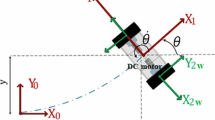Abstract
At present, the theory of wheeled robotic systems is being actively developed. In modeling the motion of wheeled robots, one mostly uses the classical nonholonomic motion model, which does not take into account the slip of deformable wheels. Meanwhile, for robots with deformable wheels, nonholonomic models can be inadequate for the design and analysis of control algorithms. This can be the case for statically unstable balancing robots with coaxial wheels, similar in design with such vehicles as Segway. Thus, modeling the motion of a two-wheeled robot taking into account the possibility of wheels slip and analysis of applicability of simplified models are of interest. Such models can be used to develop new control algorithms in active maneuvering, and for preliminary estimates of robustness of algorithms designed using approximate nonholonomic models. This paper focuses on modeling the motion of balancing robots, on analyzing their steady-state motion, and on possibilities of their stabilization. It is shown that for models with deformable wheels in the steady-state motion the body has a forward pitch. Such a pitch is not found in most nonholonomic models.
Similar content being viewed by others
References
B. I. Adamov, “Motion stabilization of Segway with parametric uncertainty and improving passenger comfort drive,” in: Conf. of Young Scient. “Navigation and Motion Control” [in Russian], Elektropribor, St. Petersburg (2013), pp. 339–343.
B. Adhikari, D. Gurung, G. S. Kunwar, and P. Gyawali, “FPGA control of a mobile inverted pendulum robot,” J. Inst. Eng., 8, No. 1, 188–196 (2011).
A. P. Aliseychik and V. E. Pavlovsky, “Model and dynamic evaluation of handling and comfort of motion of the mobile multiwheeled robot,” Probl. Upravl., No. 1, 70–78 (2013).
V. V. Andronov and V. Ph. Zhuravlev, Dry Friction in Problems of Mechanics [in Russian], Regular and Chaotic Dynamics, Moscow (2010).
A. A. Bature, S. Buyamin, M. N. Ahmad, and M. Muhammad, “A comparison of controllers for balancing two wheeled inverted pendulum robot,” Int. J. Mech. Mechatron. Eng. IJMME-IJENS, 14, No. 3, 62–68 (2014).
V. N. Belotelov and Yu. G. Martynenko, “Control of three-dimensional motion of inverted pendulum, mounted on pair of coaxial wheels,” Izv. Ross. Akad. Nauk. Mekh. Tverd. Tela, No. 6, 10–28 (2006).
A. M. Formalskii, Stabilisation and Motion Control of Unstable Objects, Walter de Gruyter, Berlin (2015).
A. D. Goverdovskii, “Automatic control of balancing robot,” in: Proc. 15th Youth Sci.-Tech. Conf. “High Technologies and Intelligent Systems,” 2013 [in Russian], Izd. MGTU im. N. E. Baumana, Moscow (2013), pp. 259–265.
D. R. Jones and K. A. Stol, “Modelling and stability control of two-wheeled robots in low-traction environments,” in: Australasian Conf. on Robotics and Automation, 2010, Brisbane, Australia, pp. 1–9.
A. Ya. Krasinskiy and D. R. Kayumova, “On the influence of wheel deformability on differential drive robot dynamics,” Russ. J. Nonlin. Dyn., 7, No. 4, 803–822 (2011).
P. A. Kruchinin and A. A. Laskin, “On models of deformable wheel rolling to description of robotic platform motion,” in: VII All-Russian Meeting of the Heads of the Departments and Teachers of Theoretical Mechanics, Robotics, Mechatronics of Universities of the Russian Federation. Materials [in Russian], Master, Makhachkala (2016), pp. 62–65.
Ch. Li, X. Gao, and K. Li, “Smooth control of the coaxial self-balance robot under impact disturbances,” Int. J. Adv. Robotic Syst., 8, No. 2, 59–67 (2011).
Yu. G. Martynenko, “Motion control of mobile wheeled robots,” J. Math. Sci., 147, no. 2, 6569–6606 (2007).
I. V. Novozhilov, P. A. Kruchinin, and M. Kh. Magomedov, “Contact forces of interaction between the wheel and the supporting surface,” in: Theoretical Mechanics, No. 23 [in Russian], Izd. Mosk. Univ., Moscow (2000), pp. 86–95.
H. B. Pacejka, Tyre and Vehicle Dynamics, Butterworth–Heinemann, Oxford (2006).
A. Salerno and J. Angeles, “The control of semi-autonomous two-wheeled robots undergoing large payload-variations,” in: Proc. IEEE Int. Conf. on Robotics and Automation 2004, Vol. 2, pp. 1740–1745.
R. S. Sharp and M. Bettella, “On the construction of a general numerical tyre shear force model from limited data,” Proc. Inst. Mech. Eng. Pt. D: J. Automobile Eng., 217, no. 3, 165–172 (2003).
A. V. Vlakhova, Mathematical Models of Wheeled Vehicle Motion [in Russian], Izhevs. Inst. Komp’yut. Issled., Moscow (2014).
J. Yi, D. Song, J. Zhang, and Z. Goodwin, “Adaptive trajectory tracking control of skid-steered mobile robots,” in: Proc. IEEE Int. Conf. on Robotics and Automation. Rome, Italy, 2007, pp. 2605–2610.
Author information
Authors and Affiliations
Corresponding author
Additional information
Translated from Fundamentalnaya i Prikladnaya Matematika, Vol. 22, No. 2, pp. 181–193, 2018.
Rights and permissions
About this article
Cite this article
Kruchinin, P.A., Laskin, A.A. Steady-State Motion of a Balancing Robot with Two Coaxial Deformable Wheels. J Math Sci 253, 881–889 (2021). https://doi.org/10.1007/s10958-021-05278-6
Published:
Issue Date:
DOI: https://doi.org/10.1007/s10958-021-05278-6




